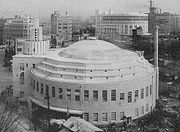The topic of this article may not meet Wikipedia's
notability guideline for biographies. (February 2012) |
Mikishi Abe | |
|---|---|
 SEIKO main office designed by Mikishi Abe | |
| Born | May 4, 1883 |
| Died | February 20, 1965 |
| Alma mater |
University of Illinois Sapporo Agricultural College |
| Occupation(s) | Architect, civil engineer |
| Practice | Abe Offices |
| Buildings | Hankyu Department Store Hibiya Movie Theatre |
| Projects | Hankyu Hanshin Toho Group overhead railways |
Mikishi Abe (阿部 美樹志, Abe Mikishi, 1883–1965) was a Japanese architect and civil engineer, known for his PhD thesis on reinforced concrete frames, and for several concrete buildings. [1] Abe was responsible for designing the first elevated railway using reinforced concrete. He contributed to many architectural and engineering works of the Hankyu Hanshin Toho Group.
Shortly after World War Two, he was the second president of the War Reconstruction Agency (currently the Ministry of Land, Infrastructure, Transport and Tourism) and the Secretary-General of the Construction Agency (Deputy Secretary of Construction) after the war. On March 4, 1947, he was appointed as a member of the Imperial House of Representatives, and remained in office until the abolition of the House of Peers on May 2, the same year. [2]
Mikishi Abe was the student of A.N Talbot of United States. He is credited of spreading the Talbot's message of pragmatism in Japan. [3]
Buildings
- Seiko Main Office
- Hibiya Movie Theater, Yurakucho, Chiyodaku, Tokyo, 1934 [4]
- Meiji Seika Tobata Factory, Tobataku, KitaKyushu, 1936
- Hankyu Nishinomiya Stadium
- Kobe Hankyu Building
- Yuraku-za Theatre
Books
- Analysis and Tests of Rigidly Connected Reinforced Concrete Frames. [5]
References
- ^ "Abe Mikishi". Nihon jinmei daijiten+Plus. Kōdansha. Retrieved 13 February 2012.
- ^ House of Representatives, House of Councils, "Hundred Year History of Parliamentary System: Aristocratic House of Representatives Directory," Ministry of Finance, Printing Bureau, 1990, p. 90.
- ^ Sozen, Mete A.; Ichinose, Toshikatsu; Pujol, Santiago (14 July 2014). Principles of Reinforced Concrete Design. CRC Press. ISBN 978-1-4822-3148-9.
- ^ Hibiya Movie Theater
- ^ Abe, Mikishi (July 2008). Analysis and Tests of Rigidly Connected Reinforced Concrete Frames. Read Books. ISBN 978-1-4086-6693-7.
The topic of this article may not meet Wikipedia's
notability guideline for biographies. (February 2012) |
Mikishi Abe | |
|---|---|
 SEIKO main office designed by Mikishi Abe | |
| Born | May 4, 1883 |
| Died | February 20, 1965 |
| Alma mater |
University of Illinois Sapporo Agricultural College |
| Occupation(s) | Architect, civil engineer |
| Practice | Abe Offices |
| Buildings | Hankyu Department Store Hibiya Movie Theatre |
| Projects | Hankyu Hanshin Toho Group overhead railways |
Mikishi Abe (阿部 美樹志, Abe Mikishi, 1883–1965) was a Japanese architect and civil engineer, known for his PhD thesis on reinforced concrete frames, and for several concrete buildings. [1] Abe was responsible for designing the first elevated railway using reinforced concrete. He contributed to many architectural and engineering works of the Hankyu Hanshin Toho Group.
Shortly after World War Two, he was the second president of the War Reconstruction Agency (currently the Ministry of Land, Infrastructure, Transport and Tourism) and the Secretary-General of the Construction Agency (Deputy Secretary of Construction) after the war. On March 4, 1947, he was appointed as a member of the Imperial House of Representatives, and remained in office until the abolition of the House of Peers on May 2, the same year. [2]
Mikishi Abe was the student of A.N Talbot of United States. He is credited of spreading the Talbot's message of pragmatism in Japan. [3]
Buildings
- Seiko Main Office
- Hibiya Movie Theater, Yurakucho, Chiyodaku, Tokyo, 1934 [4]
- Meiji Seika Tobata Factory, Tobataku, KitaKyushu, 1936
- Hankyu Nishinomiya Stadium
- Kobe Hankyu Building
- Yuraku-za Theatre
Books
- Analysis and Tests of Rigidly Connected Reinforced Concrete Frames. [5]
References
- ^ "Abe Mikishi". Nihon jinmei daijiten+Plus. Kōdansha. Retrieved 13 February 2012.
- ^ House of Representatives, House of Councils, "Hundred Year History of Parliamentary System: Aristocratic House of Representatives Directory," Ministry of Finance, Printing Bureau, 1990, p. 90.
- ^ Sozen, Mete A.; Ichinose, Toshikatsu; Pujol, Santiago (14 July 2014). Principles of Reinforced Concrete Design. CRC Press. ISBN 978-1-4822-3148-9.
- ^ Hibiya Movie Theater
- ^ Abe, Mikishi (July 2008). Analysis and Tests of Rigidly Connected Reinforced Concrete Frames. Read Books. ISBN 978-1-4086-6693-7.



